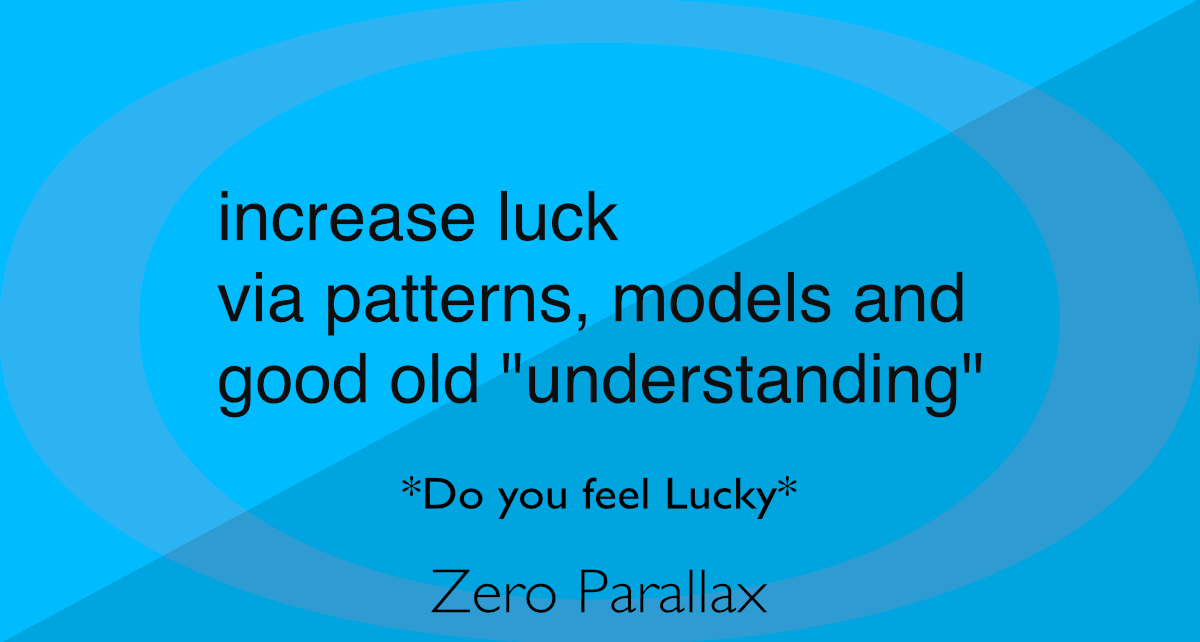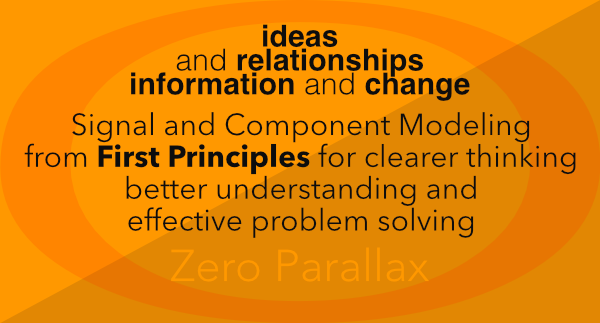Do you feel lucky?

In his article systematizing luck, psychotactics author Sean D'Souza talks about how he always used to get sick before or just at the start of going on holidays and how in comic competitions, he always tended to get 2nd or 3rd, but never 1st.
To figure out why he got colds, and why he only got 2nd or 3rd, he looked at patterns.
In the case of holidays he figured out it was because he increased his workload just prior to vacation. In the case of comic competitions, it was because he worked on three or four ideas versus just one.
Recognizing these patterns, he then figured out what to do to maximize his chances of not getting sick on holiday and of getting first place instead of second or third.
One of the first points to note is that he had the experiences first.
Then he looked back on these experiences.
Looking back on experiences
Looking back is when he realized that he tended to increase his workload just before his holidays. And because of that he weakened his body, making it more susceptible to getting sick.
Looking back is also when he realized that he worked on three or four comics, and while the first was good, the following three where mediocre. And because his creativity was spread among four pieces of work, none of them were first place material.
The US army has something called an "After Action Review".
This is more or less the same idea. We look back on something that we've done so that we can learn from it and improve.
By looking back, Sean figured out that working hard before the holidays made him sick and that working on three or four comics versus just resulted in him never getting first place.
Using clear definitions to help define the problem
In anything that we do, we always have the option of looking back on the experience. It gives us another point of view.
If we are looking back with the intent of fixing a problem or improving our performance, it helps to clearly define the parts of what we are doing. That then makes it easier to notice the things that cause the problems and also the things that we can do differently to improve our performance.
Using understanding to improve outcomes
D'souza uses the words patterns. He looked for patterns to "systemize his luck".
An alternative (and complimentary) way to look at it is that by looking back in time, and analyzing what he did, he was able to create a mental model, or if you like, understanding, of what happened and why.
With this same model he could then figure out what changes to improve the possibility of better outcomes.
The advantages of functions when programming
We tend to be creatures of habit.
I do a bit of programming on the side and one of the things I try to do as a good programming habit, is write functions.
Functions are like smaller programs within a larger program. Each of these smaller functions ideally does one simple task. And so one advantage of writing functions is that it makes code easier to understand.
Instead of one long page of code, you get blocks of code that use functions. The functions are easy to understand at glance and thus the program as a whole becomes easier to understand.
Another advantages of functions is that you only have to write a piece of code once. Instead of having the same code multiple times, you put it in a function and simply call that function.
Habits are like functions
For ourselves, habits are the equivalent of functions. Instead of thinking about how to do something, habits allow us to do things without thinking.
For example, learning to drive a car, what we learn are habits. We tend to call these "muscle memory", but they are the same thing. We learn how to brake, accelerate, steer, all without thinking. As a result, while driving, instead of having to figure out how to use the brakes, we can just use the brakes whenever it is required.
Working at a restaurant, I learned, eventually, how to make a variety of different pizzas. One of the challenges for me was in how to open a dough ball and turn it into a pizza base. Eventually I learned to do it. I still have to focus, but now I can open pizza easily, and cook other dishes, because I've learned how. The making of these different things has been memorized and turned into "habits".
Basically a habit is anything that is stored in memory. We have a model of that thing.
As an example, calling someone by name is a "habit".
As another example, saying two whenever someone asks (or you see written on a piece of paper) what is 2+2?
Habits make our lives easier. But they also mean that we tend to do things the same way.
And so for Sean, he always worked hard before vacation, or, he always did four comics. He had to look back to notice these habits so that he could change them.
What he then did was modify his habits or create new ones.
Habits and mental models
So how do habits tie into mental models?
I'll suggest here that models and habits can be the same things. Or models, can include habits.
A model can be like a large program in our consciousness, with lots of habits that are in turn smaller models.
When we train new habits, we modify our mental models.
Or, when we begin creating or modifying our mental models, part of that includes modifying our habits.
In either case, the steps to doing this are to have experiences, and then to look back on those experiences.
When talking about mental models and habits, I tend to use terminology like ideas, relationships and systems. I use these terms so that I can think with greater flexibility.
So for example:
an idea something that is clearly defined and that creates a change when connected to another idea. It is the potential for change.
A relationship is two connected ideas. A relationship is where the potential of both ideas is "realized".
A simple example of this is that a torch and a battery can each be viewed as ideas. Put them together and you have a relationship, one that allows the torch to light up (while draining the battery in the process).
A system is a network of connected ideas and relationships.
Note that both relationships and systems can be viewed as ideas.
Likewise, ideas can contain relationships or systems.
One thing that is common to all of the above is that they are all "clearly defined".
All that being said, lets use the idea of patterns for a moment.
Changing the way that we act
How can we use the concept of patterns to explain all of the above?
We could suggest that models are like patterns in our consciousness (or in our "brain"). These patterns determine how we act in certain circumstances.
If we want to change how we act, then we have to change the patterns in our consciousness.
But to do this, it helps to see the patterns first. We detect the patterns by looking at how we've acted in particular scenarios. We see the patterns, we notice the changes that we'd like to make in those patterns. We then repeat the experiences with the modified patterns in place. We notice the results.
Note that the first time or first few times executing a new or modified pattern may be difficult until these patterns become embedded.
But then they become self-sustaining patterns.
Adding some flexibility
Note that another approach to all of this is to develop optional patterns. If Sean started getting first place prizes, he might on occasion decide to work on two comics versus just one. Or on occasion, he might decide on occasion to work hard before a holiday (but not too much).
Rather than being rigid, he then has some flexibility in how he acts.
And of course, he can evaluate the experiences and note the results on these "special" occasions.
Making Patterns Modular
Another approach to this patterning is to work on smaller "Modular" and thus "reusable" patterns.
Patterns are made up of smaller patterns and can in turn be a part of larger patterns. When you realize the scalable nature of patterns (or if you like, their fractal nature) you can then begin working on modular patterns.
Why?
So that the process of pattern modifying and embedding patterns is more efficient.
Imagine patterns that you can re-use over and over again in different activities. It can make the process of experiencing and then looking back to improve patterning more efficient.
Muscle control as a modular approach to learning your body
It's one reason why, as a (yoga) teacher, I teach muscle control. I could teach poses, but if I teach students how to feel and control their muscles, they can then use that sensitivity and control in any activity, not just yoga.
Note that muscles are the equivalent of a screen on a smart device. Smart device screens act as both the main input and the main output. From the devices perspective, the screen is where it gets inputs, and the screen is where is sends outputs or "responses".
With muscles, they generate forces that allow us to use our body. When active, muscles generate sensation that is proportional to the amount of force they output. They also generate sensation in connective tissue that is proportional to the amount of stretch. These two quantities help our brains figure out how to move our body while at the same time telling it what our body is currently doing. Thus our brain can accurately get our body to do what we want it to do.
And so when I teach muscle control, I'm teaching my students to be conscious of these very same things. As a result, they improve their body awareness, and body control, by tuning into the very things that move our body and that allow us to sense it.
In the face of any new activity, they still have to learn the activity, but now, instead of learning their body and the new activity, they can focus on the new activity.
Turning muscle control into a habit
I should point out here that I don't focus on teaching students to controll all of their muscles at once. Instead, and this is a little like Sean choosing to focus on doing one comic strip instead of many, I focus on teaching students to feel one muscle or one set of muscles in relative isolation. Thus they can learn to feel and control that particular muscle, turning the ability to feel and control it into a habit.
Getting back to patterns in general, whether you work at making smaller re-usable patterns, or whether you work at just changing your patterns, the important point is that you need experiences, and you need to look back on those experiences.
It's these dual points of view that enable us to learn.
This "dual point of view" modelling can apply to learning any type of system.
The better your models or patterns, the better your understanding, and the better your chance of systematizing or maximizing the possibility of being lucky.
